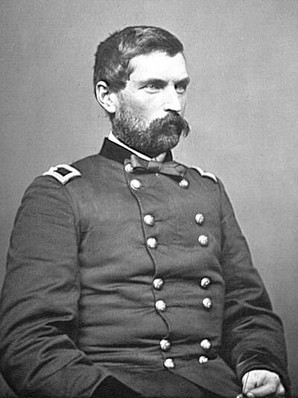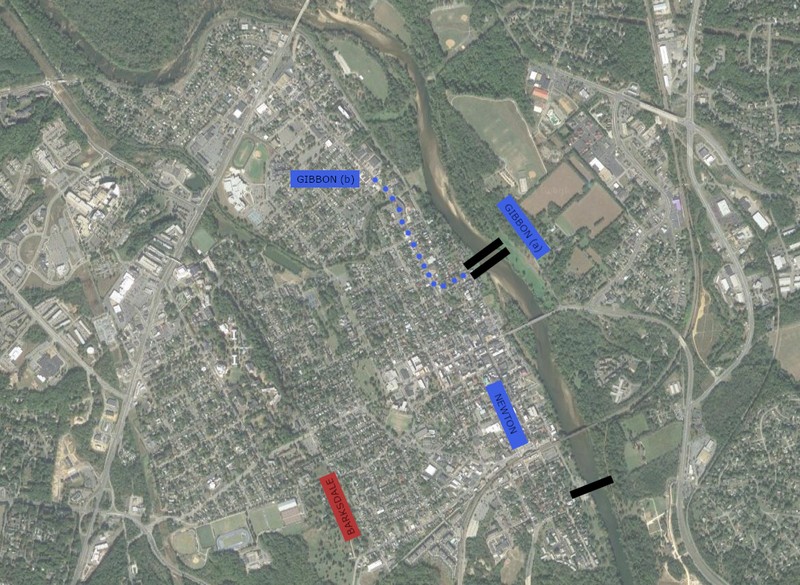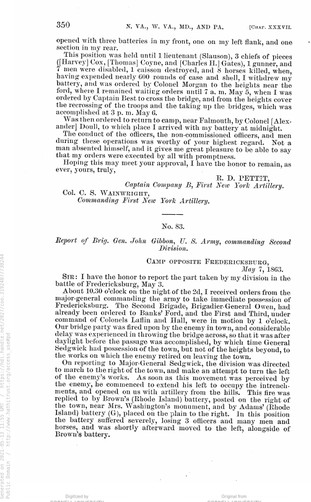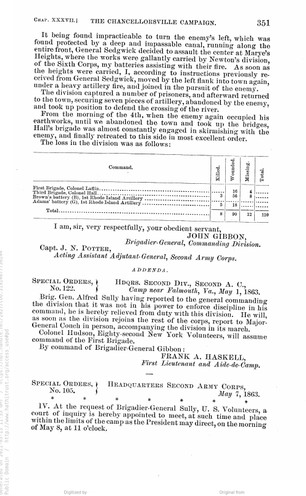John Gibbon's Second Division, II Corps, Crosses the Rappahannock, May 3, 1863 (6:30am)
Introduction
Text-to-speech Audio
Images
Brig. Gen. John Gibbon (commanding Second Division, II Corps)

Gibbon's II Corps division crosses the Rappahannock and moves north of Fredericksburg (map by Kathleen Thompson)

Report of Brig. Gen. John Gibbon, page 1

Report of Brig. Gen. John Gibbon, page 2

Backstory and Context
Text-to-speech Audio
Brig. Gen. John Gibbon’s Second Division of the II Corps had been stationed across from Fredericksburg for the entire Chancellorsville campaign to this point. While the rest of Major General Darius N. Couch’s II Corps swung north and west with Hooker’s main thrust, Gibbon’s Division was tasked to stay in the Falmouth camps with Sickles’ III Corps as the diversion to fool Lee into thinking the Union force remained across from the city. When the III Corps and then the I Corps were pulled west to Chancellorsville, Gibbon’s men remained in place.
Sedgwick’s orders on the night of May 2 included orders that Gibbon cross the Rappahannock and take Fredericksburg. Gibbon started preparing for a forced crossing of the river, but Sedgwick’s arrival in the city meant that Gibbon’s men could use the pontoon bridges being floated up and secured across from the Lacy house. The first bridge was complete around 6:30am on May 3 and Gibbon’s troops started to cross the Rappahannock and rest on Princess Ann Street until they received their orders.
Consulting with Sedgwick and his staff in Fredericksburg, Gibbon’s orders were to deploy his division to the north of the city (he would be the right flank of the Union line) and attack the heights on that end. Sedgwick hoped that Gibbon’s maneuver would force Early to shift his troops to protect his flank.
Cite This Entry
Thompson, Kathleen. "John Gibbon's Second Division, II Corps, Crosses the Rappahannock, May 3, 1863 (6:30am)." Clio: Your Guide to History. May 13, 2021. Accessed April 11, 2025. https://theclio.com/entry/10778/tour/4
Sources
Furgurson, Ernest B. Chancellorsville, 1863: The Souls of the Brave. New York: Vintage Books, 1992.
Gallagher, Gary W. The Battle of Chancellorsville. National Park Civil War Series. Eastern National, 2007.
Parsons, Philip W. The Union Sixth Army Corps in the Chancellorsville Campaign: A Study of the Engagements of Second Fredericksburg, Salem Church and Banks’s Ford, May 3-4, 1863. Jefferson, NC: McFarland & Company, Inc., 2006.
Sutherland, Daniel E. Fredericksburg and Chancellorsville: The Dare Mark Campaign. Lincoln: University of Nebraska Press, 1998.
"John Gibbon." Wikipedia. Accessed May 4, 2021. https://en.wikipedia.org/wiki/John_Gibbon
Map by Kathleen Thompson
The War of the Rebellion: A Compilation of the Official Records of the Union and Confederate Armies. Series I-Volume XXV-Part I-Reports, page 350. Accessed May 12, 2021. https://babel.hathitrust.org/cgi/pt?id=coo.31924077730244&view=1up&seq=3.
The War of the Rebellion: A Compilation of the Official Records of the Union and Confederate Armies. Series I-Volume XXV-Part I-Reports, page 351. Accessed May 12, 2021. https://babel.hathitrust.org/cgi/pt?id=coo.31924077730244&view=1up&seq=3.

